
Poa is a genus of about 570 species of grasses, native to the temperate regions of both hemispheres. Common names include meadow-grass, bluegrass, tussock, and speargrass. Poa is Greek for "fodder". Poa are members of the subfamily Pooideae of the family Poaceae.

Poa annua, or annual meadow grass, is a widespread low-growing turfgrass in temperate climates. Notwithstanding the reference to annual plant in its name, perennial bio-types do exist. This grass may have originated as a hybrid between Poa supina and Poa infirma.

Poa trivialis, is a perennial plant regarded in the US as an ornamental plant. It is part of the grass family.
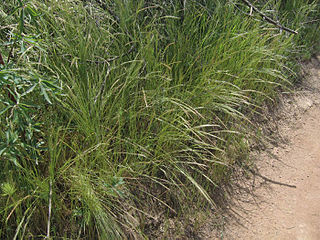
Vulpia myuros, the annual fescue, or rat's-tail fescue, is an annual grass species of the genus Vulpia. It was probably originally native to Eurasia, but it can now be found nearly worldwide as a naturalized species.

Stellaria graminea is a species of flowering plant in the family Caryophyllaceae known by the common names common starwort, grass-leaved stitchwort, lesser stitchwort and grass-like starwort.

Festuca rubra is a species of grass known by the common name red fescue or creeping red fescue. It is widespread across much of the Northern Hemisphere and can tolerate many habitats and climates. It is best adapted to well-drained soils in cool, temperate climates; it prefers shadier areas and is often planted for its shade tolerance. Wild animals browse it, but it has not been important for domestic forage due to low productivity and palatability. It is also an ornamental plant for gardens.
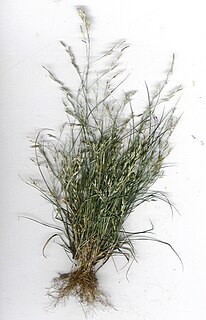
Eragrostis pectinacea is a species of grass known by the common name tufted lovegrass. This plant is native to the Americas from Canada to Argentina. It is widespread, growing in most open spaces at varying elevations and habitats, including in disturbed areas and roadsides.

Aira praecox is a species of grass known by several common names, including early hair-grass, yellow hairgrass and spike hairgrass. It is native to Europe, where it is found in dry, sandy places, on rocky outcrops, and in heath grassland. It also grows in North America as an introduced species, where it can be found on the east and west coasts in sandy or rocky areas, such as beaches and roadsides. This is a tuft-forming annual grass growing up to about 25 centimeters in maximum height. The thin, narrow leaves are located at the base of the stem, and are typically 0.3–2 millimeters wide. It bears very small inflorescences of purple-tinted green bisexual spikelets.
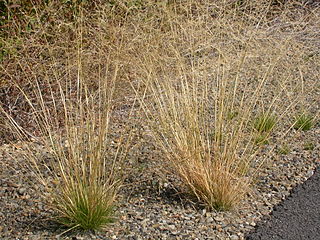
Agrostis scabra is a common species of grass known by the common names hair grass, rough bent, rough bent grass, winter bent grass, and ticklegrass. A tumbleweed, it is a bunchgrass native to Asia and much of North America, and widely known elsewhere as an introduced species.
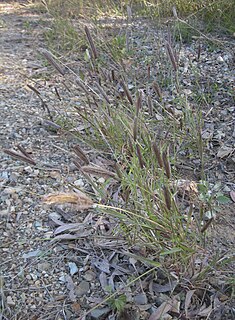
Chloris virgata is a species of grass known by the common names feather fingergrassfeathery Rhodes-grass and feather windmillgrass.

Cynosurus echinatus is a species of grass known by the common names bristly dogstail grass, rough dog's-tail and hedgehog dogtail. It is native to southern Europe, and it is known in the Americas and Australia as an introduced species and sometimes a noxious weed. An herbicide-resistant strain can be found growing as a weed in canola and wheat fields in Chile. This is an annual grass growing 10 to 50 centimeters tall. The inflorescence is a rounded or oval cluster or series of clusters of spikelets. The fertile spikelet has an awn up to a centimeter long. The awns clumped closely together into a tuft gives the inflorescence its bristly, hairy appearance.

Poa compressa, the Canada bluegrass or flattened meadow-grass, is a perennial flattened meadow grass, similar to common meadow-grass, Poa pratensis. It is native to Europe but it can be found nearly worldwide as an introduced species. It grows in old wall tops, pavement cracks, dry stony grassland, and many types of wild habitat. It has a flattened stem, 23–30 cm tall, a close one sided panicle of grey green, with purple florets.

Poa atropurpurea is a rare species of grass known by the common name San Bernardino bluegrass. It is endemic to southern California, where it is known from two regions, the San Bernardino Mountains near Big Bear and the Laguna Mountains of San Diego County.

Poa bigelovii is a species of grass known by the common name Bigelow's bluegrass. It is native to the southwestern United States and northwestern Mexico, where it grows in shady spots in desert and plateau habitat.
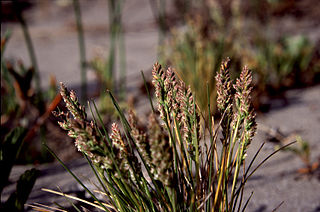
Poa confinis is a species of grass known by the common names coastline bluegrass and beach bluegrass. It is native to the coastline of western North America from British Columbia to northern California, where it grows on beaches, dunes, and other coastal habitat.

Poa glauca is a species of grass known by the common names glaucous bluegrass, glaucous meadow-grass and white bluegrass. It has a circumboreal distribution, occurring throughout the northern regions of the Northern Hemisphere. It is also known from Patagonia. It is a common grass, occurring in Arctic and alpine climates and other areas. It can be found throughout the Canadian Arctic Archipelago in many types of habitat, including disturbed and barren areas.

Schismus barbatus is a species of grass known as common Mediterranean grass and kelch-grass. It is native to Eurasia, and it is also known as an introduced species in the southwestern United States. It grows in many habitats, including disturbed areas. It is an annual grass growing in small clumps. The stems grow up to 27 centimeters long and are lined with threadlike leaves. The short inflorescence bears spikelets under a centimeter long.

Setaria verticillata is a species of grass known by the common names hooked bristlegrass, rough bristle-grass and bristly foxtail. It is native to Europe, but it is known on most continents as an introduced species and often a noxious weed. It is a hardy bunchgrass which grows in many types of urban, cultivated, and disturbed habitat. It is a weed of many types of agricultural crops, growing in vineyards and fields. Herbicide-resistant strains have been noted.

Tamarix chinensis is a species of tamarisk known by the common names five-stamen tamarisk and Chinese tamarisk or saltcedar. It is native to China and Korea, and it is known in many other parts of the world as an introduced species and sometimes an invasive noxious weed. It easily inhabits moist habitat with saline soils. It may grow as a tree with a single trunk or as a shrub with several spreading erect branches reaching 6 metres or more in maximum height. It has been known to reach 12 metres. It has reddish, brown, or black bark. The small, multibranched twigs are covered in small lance-shaped, scale-like leaves which are no more than about 3 mm long. The inflorescence is a dense raceme of flowers a few cm long. Each fragrant flower has five petals which are usually pink but range from white to red.
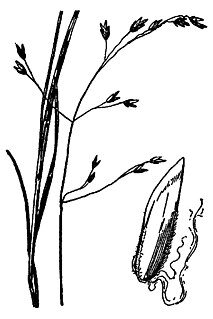
Poa paludigena is a species of grass known by the common names bog bluegrass, marsh bluegrass, slender marsh bluegrass, and Patterson's bluegrass. It is native to the northeastern United States.




















